|
|
|
|
Introduction to the Violin, Viola & Cello
|
1. Elephant parachutist
| 2. Autumn Rain
| 3. From Cardiff to London
| 4. Clown Dance
| 5. Jumping Ponies
| 6. All four strings
| 7. The Squirrel
| 8. The General
| 9. Snakes & Ladders
| 10. Strawberry Banana
| 11. Chocolate Mousse
| 12. String Waltz
| 13. The Doll's Waltz
| 14. Wagon Train | |
![]()
Below : A good bend in the little finger, so important for balancing the bow at the heel. Later, this will become important as chords and heel détaché are taught. When teaching small children do not fuss too much about the position of each finger on the bow. If you do they will be put off fairly quickly ! Try to achieve a bend in the thumb as one of the first priorities. I personally teach all 14 of these pieces with insisting on any particular bow hold unless the student is older ( 6+ ). Think of how a small child holds a crayon, and it will become clear that they have no particular method at this early stage in life.
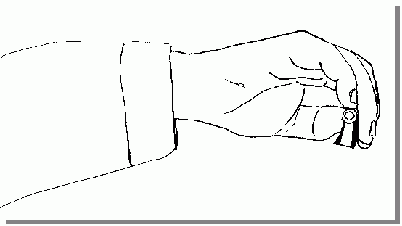
![]()
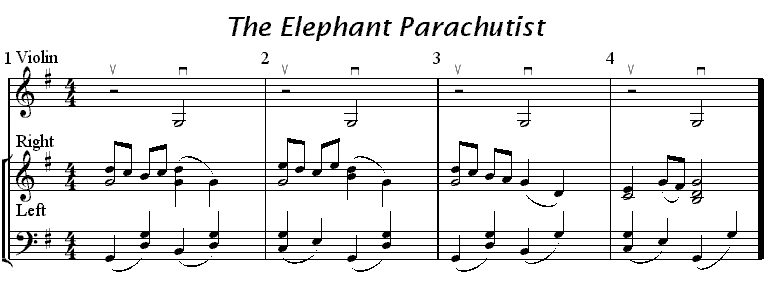
![]()
1. The Elephant Parachutist
This piece is to be played slowly, with a sustained tone ( that includes the pianist too !). The Violinist should start with his / her bow raised up in the air. During the first rest a huge up bow arc is described with the right arm, eventually bringing the bow on the G string at the heel. The whole bow is drawn slowly on the open G producing an “elephant” sized sound. Though the bow must thoroughly adhere to the string for as long a down bow as possible, it should neither skate or slip across the string, nor should it squeeze and force the sound. The right hand is continuously following a huge imaginary circle, counter-clockwise from where the student stands. The bow should be lifted as high as possible during the rest, and this great arc helps the child reach that remotely strung G string ! The circle described should be slow and smooth, as if the music were still being bowed or played.
This piece is very popular with children, and gives them the means to develop a beautifully rich sound full of bass. If the teacher cares to play together with the pupil, providing the strings are tuned together, the pupil will feel "his" sound has suddenly doubled in capacity ! Finally it is possible for each child to play a note sequentially in a group ; this way the more sensitive and refined hands of the better student will set an example for the weaker ones to follow. Much depends on setting a good example. Though the g string is harder to reach at first, the child will soon be rewarded by an introductory sound far superior to that of the E string.
Warning ; do not give up this piece after 3 lessons as it can be kept in the repertoire for at least a year as a warming up exercise. Even when your pupil sounds good, encourage him / her to sing from the first millimeter of bow to the last. The whole process is similar to spreading chocolate spread on a slice of bread. The final result should be a sound ever bit as appetizing !!
![]()

![]()
2. Raindrops ( Autumn Rain )
Raindrops can also be played pizzicato. The harmonic progression is very romantic in its resolution, and adds a most interesting background to what must be the easiest piece conceivable. The main objective of this piece is to get the pupil to pluck or bow to a regular "tick tock" beat. Sensitive players will know when the last note comes and there must be no attempt to count how many notes there are. The pianist should play mezzo piano while the open Ds are played mezzo forte. Once this piece has been played through go straight on to something else. Its sole purpose plucking is to keep the beat, but bowing it has the added benefit of encouraging plain and even bowing. This may be likened to a very broad détaché, passing through the middle of the bow, or, the pupil may chose to use almost the whole bow as his / her bowing skills improve throughout the term.
![]()

3. From Cardiff to London
The Main purpose of this exercise is to encourage the pupil to draw the bow from heel to tip and vice versa. At first this will seem an impossible task, especially for those who grip the bow too strongly. They will have difficulty in reaching the tip, and a certain amount of manual intervention on the teacher’s part often becomes necessary. If it is determined that the bow is too long for the student then a marker should be placed to indicate the tip of the bow.
The bow should be drawn at an even and moderate speed, and the exercise should not be repeated too many times in succession, not to tire the children's arms. This simple exercise, when properly inserted between pieces, will act as a catalyst in learning to use the whole bow.
![]()
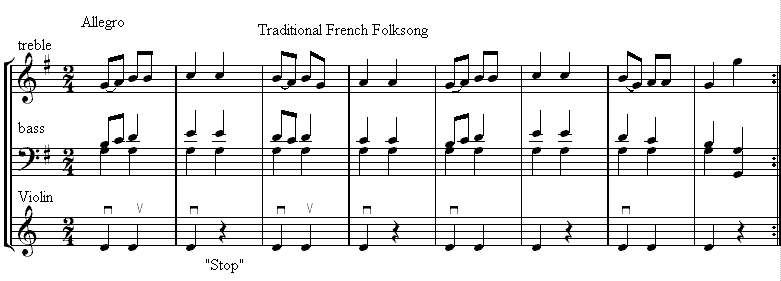
![]()
4. Clown Dance ( Traditional French )
This is quite a lively piece, to be played with however many repeats it takes to attain some fluency in bowing, and a solid sense of rhythm. It is imperative to follow the right bowing. The student should shout out aloud "stop" or "rest" during the crotchet rest, as this will clarify the pupils rhythmic understanding. The tempo can be anything from Allegro Moderato to Allegro Assai, and faster tempos will usually encourage a faster bow speed. This is especially important in order to avoid a sluggish or lifeless use of the bow. The rest helps to strengthen the bow hold, as it is obliged to retake almost a whole bows length in little time. It is also a tremendously contagious piece rhythmically. The D string should be played with sufficient lightness of bowing, in contrast to Elephant Parachutist.
Initially the piece may be started pizzicato, each member of the group taking it in turns to pluck the 3 Ds. Eventually some familiarity with the rhythm will be reached, and bowing can begin, even if just a small portion in the middle is used. This will soon broaden out both in “carrying” power and bow length used. Below - Even a small amount of bow may have to suffice for the first few lessons. The ultimate goal is fast, light and stylish bowing.
![]()
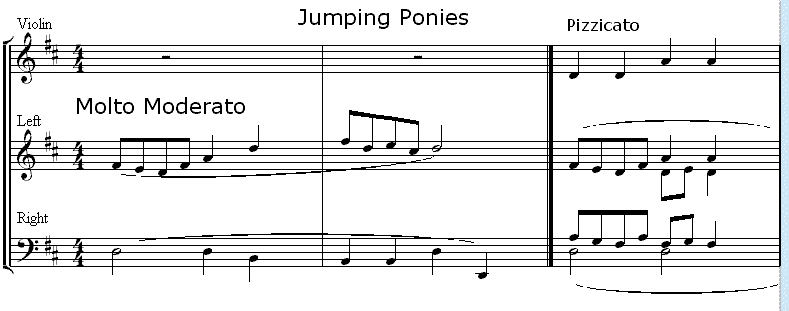
, 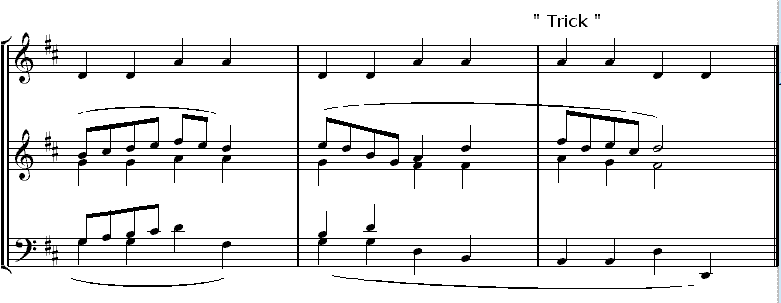
5. Jumping Ponies ( First Performance )
This piece can be played pizzicato. The main test here is to know when the sequence changes to a a d d at the end. Children invariably ask how many notes they have to count before the ending, but it is important that they perceive this inevitable conclusion to the phrase by ear. Tempo should be crotchet = 60, or faster, but must remain Moderato.
Posture
During the easier pieces it may be a good idea to pay attention to basic posture. Some general points to check : Feet - one under each shoulder. Weight equally on both feet. Feet parallel as if on a railway track. Violin Tailpiece button in the centre of the neck, with no gap between neck and violin. Violin held horizontally and at approx. 45 degrees from the front towards the left side of the body. Eyes looking at scroll, and head not tilted sideways. Left hand holding the violin body, and Right elbow on a plain with the Right hand. Torso not twisted, but shoulder axis in the same direction as the hip axis. Body upright and not slanting or arched. All this can be considered general posture and does not touch the subject of the bow hold. ( Discussed later ).
![]()
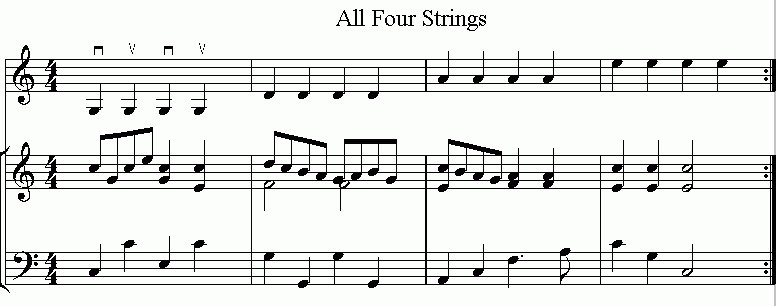
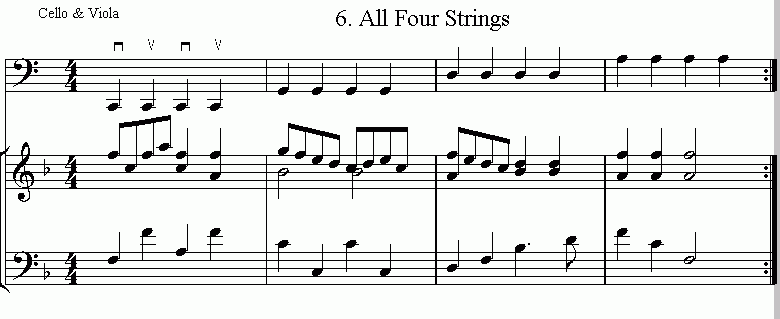
6. All 4 Strings
Use a generous amount of bow for each note. As bowing freedom increases work towards using the whole bow eventually. This piece could be played plucking for the first few times, while counting out aloud to avoid any confusion. This piece is also extremely easy, so it could precede any of the earlier pieces, as long as the student is successful at it. The E string is probably the hardest string to play pleasingly, as the slightest excess pressure can create a harsh sound. If the pupil becomes used to harsh sounds early on, then this habit will be hard to break. It must be remembered that the best tone is usually not the loudest sound, but a very sweet timbre. This is the direction in which one must aim ; dolce rather than forte.
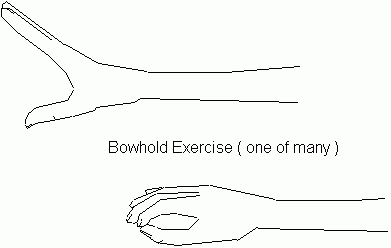
Above : The “Quack Quack” exercise for holding the bow. To be performed slowly. The hand is opened and closed slowly as the pupil says “quack.” When reaching and arriving finally at the bow, the thumb should be placed between the leather and the frog in a bent and rounded way. The middle finger should be opposite the thumb, and should wrap around the bow until it almost touches the silver guard on the frog ( where the hairs meet the frog ).
![]()
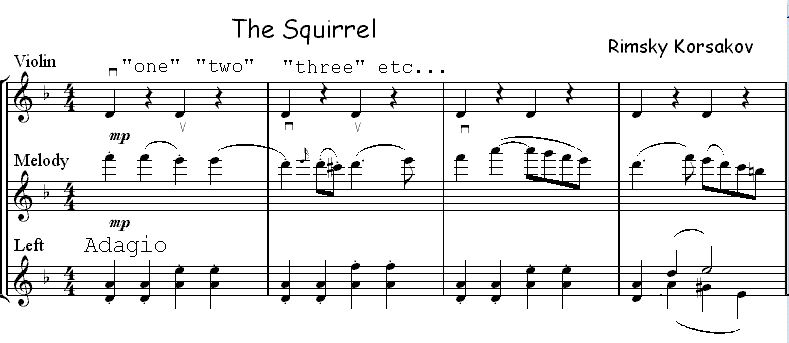
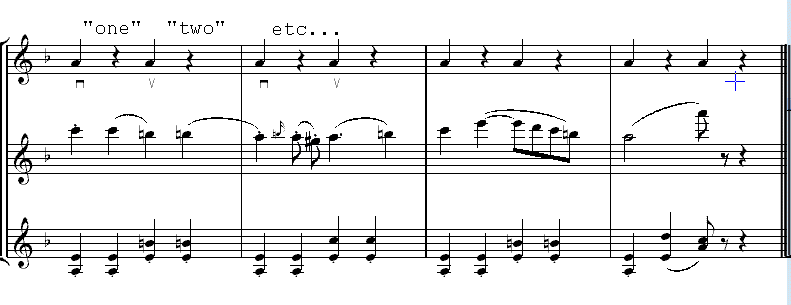
![]()
7. The Squirrel
This piece must be regarded as a jewel in the open-string literature. The Pianists right hand must be extremely lyrical in shape, with delicate but short and punctual left hand chords. Beginners can rarely co-ordinate their playing and counting for the first few lessons. "You play, you count". Note the bow should never leave the string throughout the entire piece. During the pause it rests silently on the string at the point where it arrived at the end of the last note. Bowing quantity should be increased slightly as more control of the bow is attained. The bow must travel uniformly and evenly without acceleration or irregularities to produce an even tone. Below : The area of bow which can be used for The Squirrel and its first bowing variation. An ideal skill would be to play the piece using any part of the bow.
 Bowing
quantity should be increased - The bow must travel uniformly and evenly without
acceleration or irregularities.
Bowing
quantity should be increased - The bow must travel uniformly and evenly without
acceleration or irregularities.
Variations.
The timbre should be light and piano, especially when the child's use of the bow becomes more mature. The following rhythmic variations may be tackled once the above has been mastered.:


The second variation utilizes the whole bow, by adding the 2 halves together. In the lower half the elbow follows the hand exactly, as if it were traveling down a corridor. In the Upper half of the bow, ( from middle “m” to tip “t” ), the elbow remains almost stationary, while the forearm opens up, moving away from the body. In the illustration below note the inner wrist pointing at the nose at the heel, and note the straight line in which the hand moves from heel to tip. This represents drawing a straight bow.
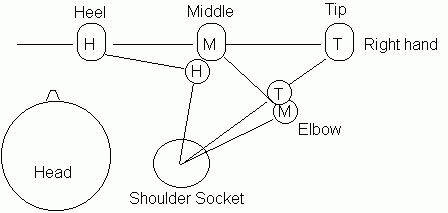
Below - The 2nd variation attempts to teach the use of the whole bow by breaking up the movement into 2 halves. The mechanism involved is markedly different in both halves.

![]()
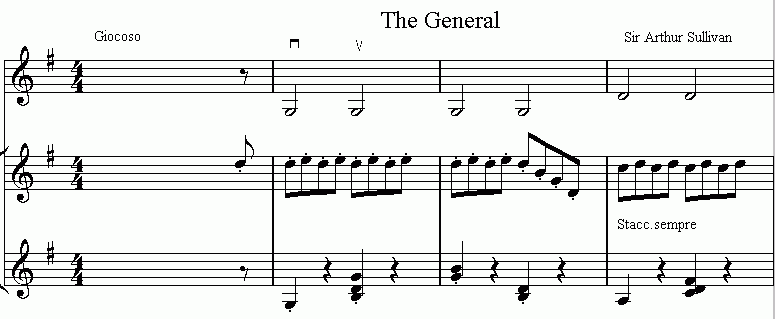
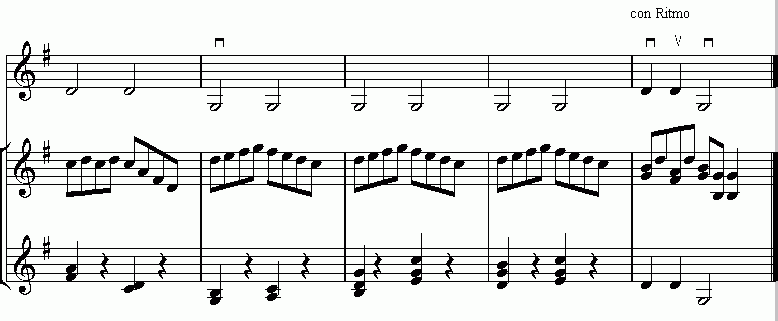
8. The General
The repertoire becomes more complex. It is possible to teach this sequence of notes simply repeating this phrase : “ 4 Gs , 4 Ds , 6 Gs , and the command. “ Use full bows on the minims, and play the piece with a loud and strong rhythm. After all Generals do tend to shout out their orders !
Playing by Ear
Start by teaching the ending, or the “command” ( D D G ) first. The teacher could play it first, and then ask the better players ( who are more likely to succeed ) to produce an exact cop ( or “photocopy” ). This technique of copying a short phrase becomes an invaluable skill and helps to quicken the pupils hearing and understanding of the notes. Do not help the student too much, or he / she will not be forced to think for themselves, working out the notes by trial and error, until they arrive at the correct conclusion. This technique develops playing by ear. All the pieces in this first stage should be played by ear, or by heart, committing the technical and musical contents to memory by repeating them each lesson. This method enables a more complete assimilation of the styles and nature of violin playing.
![]()
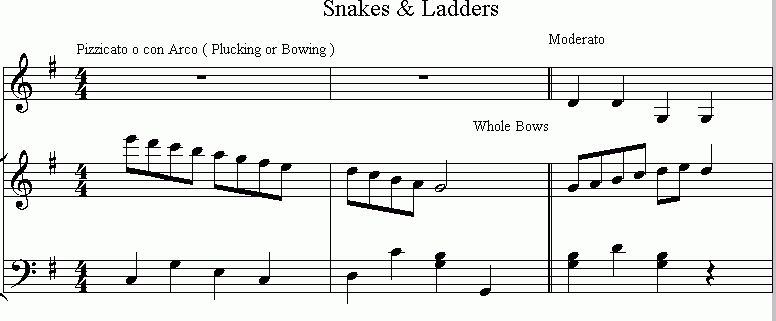
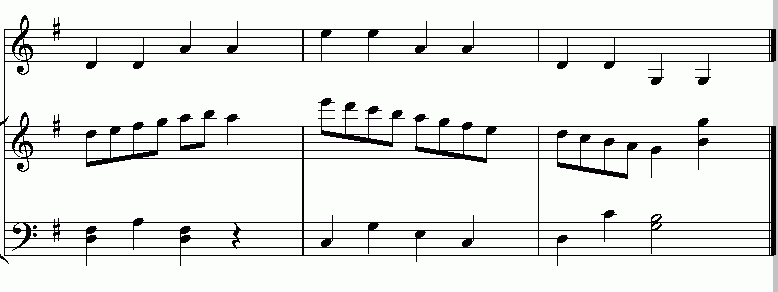
9. Snakes & Ladders
Not to be played too fast....actually andante, but allowing a full and sustained use of the bow. At all times the pianist must be aware of the bow and its singing power. Rushing the tempo could destroy the calmness needed for the bow hairs to accumulate sound by being in constant friction with the strings.
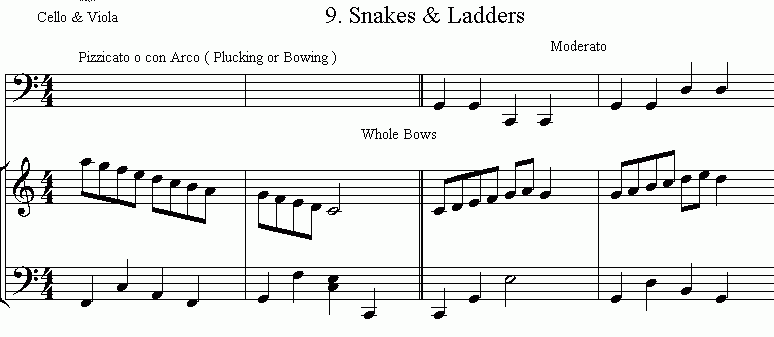
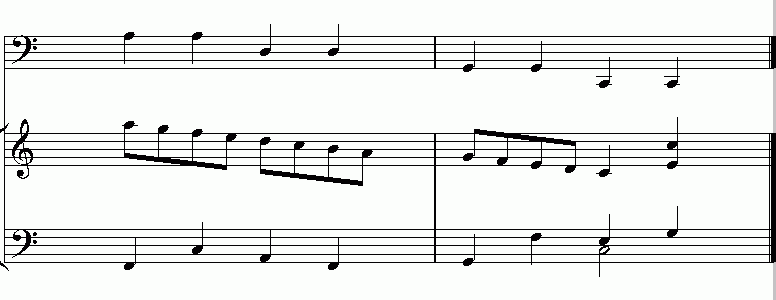
![]()
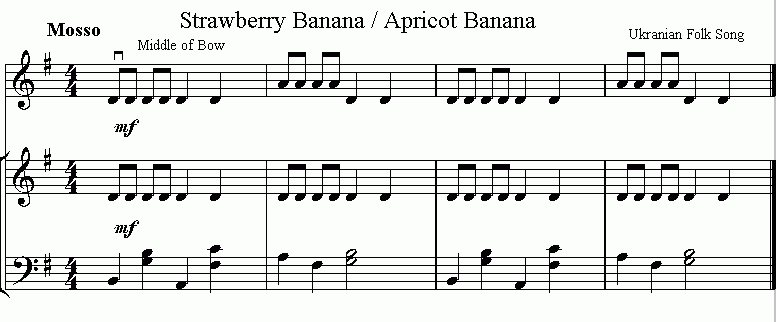
10. Strawberry Banana
To be played in the middle of the bow. Use small bow on the strawberries and a longer bow on the bananas. Note Bananas are longer than strawberries in real life too. Make sure the first note is attacked clearly. This piece is played with the forearm.
![]()
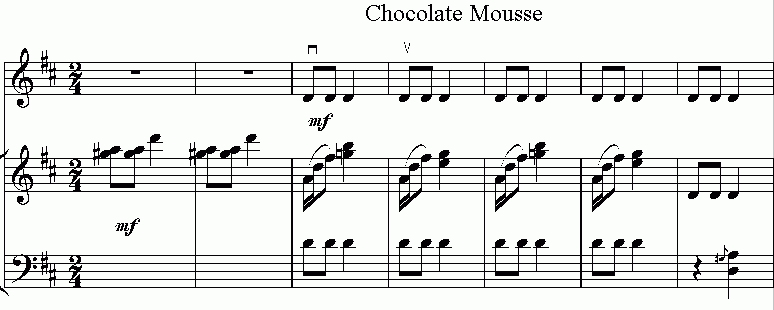
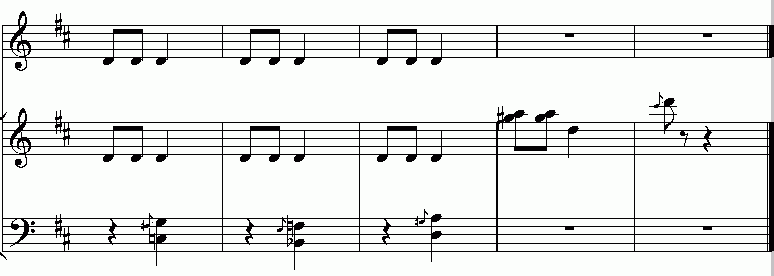
11. Chocolate Mousse
Another rhythm piece, but with an added element of bowing distribution. The Quantity should be distributed thus : Short , Short , Long - Short , Short , Long. Whatever quantity of bow is being used it should always pass through the middle. As with raindrops, the pupil should listen to the accompaniment to know where to stop. No counting the bars !
![]()
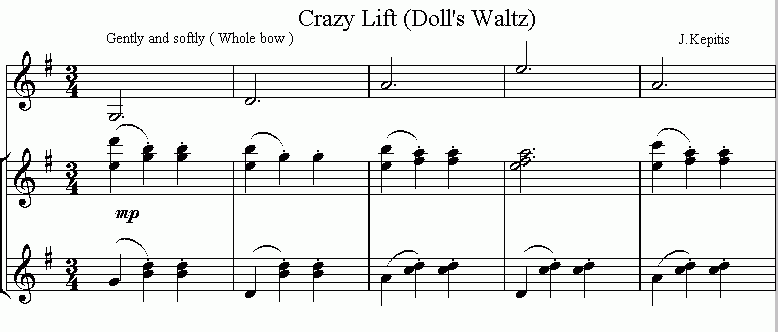
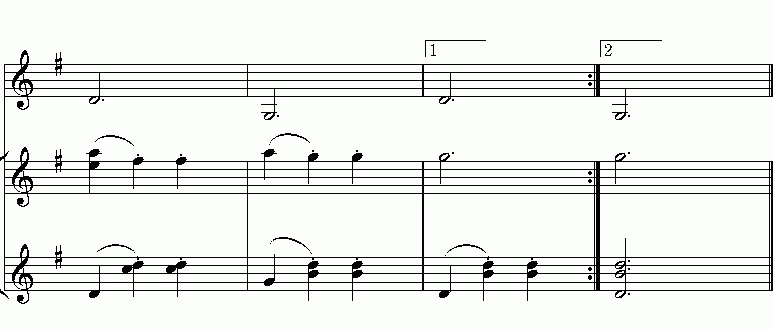
13. The Doll's Waltz ( Crazy Lift )
![]()
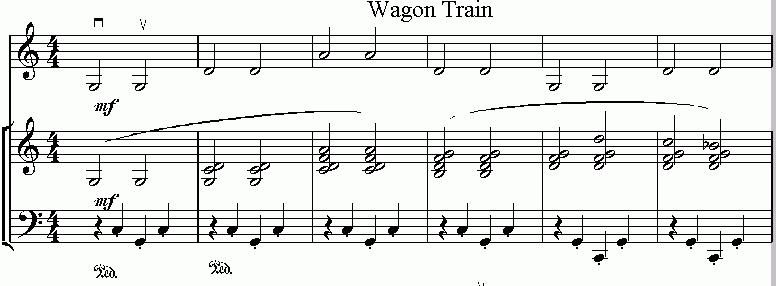
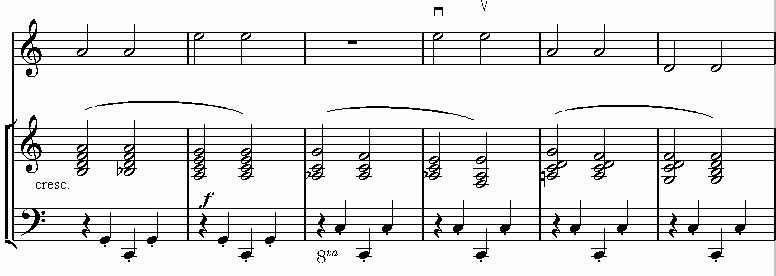
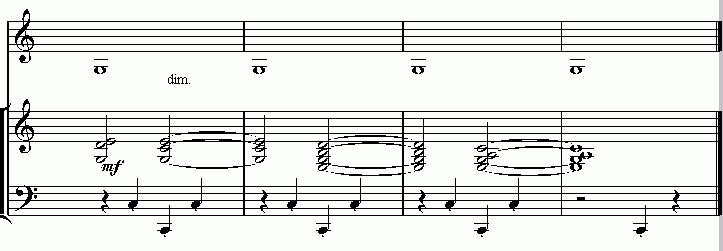
14. Wagon Train
This piece starts softly, then crescendos in the middle and finally dies back down to a pianissimo. ( using rallentando as well at the end ). These dynamics should be achieved by using more bow, rather than more weight on the string. Remember not to overload the E string ( this is where too much pressure can spoil the sound ). Just use the whole bow freely, projecting as much sound as possible. Below : Version for Cellos & violas
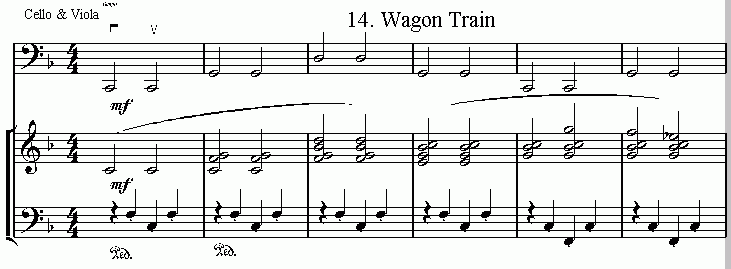
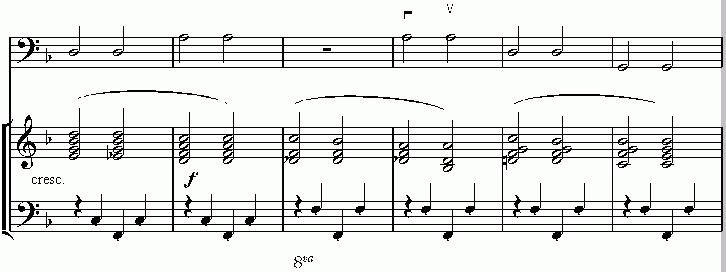

![]()
![]()
Contents
Violinistic goals - Goals for the Cello - Musical goals - Parents - Creating the environment
![]()
Main Objectives
The first lessons may be considered the most critical, as they must instill a correct approach towards the study of the violin and the cello, and, in addition, provide a solid foundation for all future musical and technical development. This course consists of an open string repertoire ( it cuts no corners ) and concentrates on superior sound quality. By completion of this 14 to 20 lesson course a pupil should ideally be able to demonstrate :
· A capacity to use the bow freely, with certain abandon and good style, in order to produce sound of excellent quality.
· A musical desire to join, sustain and "sing" all notes, leading to a degree of continuity and musical phrasing.
· A healthy posture of the whole body ( including feet ) and an acceptable bow hold.
· A very good sense of rhythm and tempo, a sensitive ear, and a musical memory.
· A love of the repertoire, an enthusiasm for good work and exemplary behaviour within the group.
Violinistic Goals
Problems need to be faced one at a time. The following clarifications are
relevant :
· The art of bowing is to be the first objective. Advantage is to be taken of
the child's young age, and their flexibility or readiness to improve manual
movement and co-ordination.
· The G string ( as opposed to the E ) should be the first tackled. The bass
component or body of sound attainable is a worthy and rewarding objective which
will enable the student to acquire superior qualities in sound production in
later years.
· The next strings should be D, A and E in that order. The E string must be
played with a flowing bow and with extreme delicacy. At no time should the tone
be “forced”.
· Posture : Feet are to be positioned with discipline. One foot firmly under
each shoulder and as if on a railway track. This "study" posture
provides equal balance and solidity of stance ideal for freedom in both hands.
· The quantity of bow used should be increased from a few inches to the whole
bow. This transition should take place gradually, as the right hand muscles are
toned and arm freedom developed throughout the term.
· The quantity of "genuine" sound should increase noticeably
throughout the term
· The left hand should be comfortably wrapped around the upper body of the
instrument. A faster program may include some left hand work during the closing
stages of the first term. It is also an appropriate program for older pupils or
for a less thorough preparation.
· The right hand fingers are not to be constantly fussed about and altered by
the Teacher. ( This could stifle a natural bowing arm movement ). Rudimentary
bow holds may be practised using a pencil, and improvements will be made
naturally and will gradually take course as more bow is used throughout the
term.
· The bow hold should develop gradually throughout the term in tandem with
mastering the whole bow length. A bent thumb ( in the right direction ! ) , a
curved 4th finger and a ring between thumb and middle finger, as well as correct
height of elbow and wrist are desirable goals to work toward using the given
repertoire.
· Towards the second half of term longer and more demanding pieces are
introduced. Dynamics and timbre are introduced as the bowing hand becomes more
sensitive.
· Methods for fine tuning the pupils style will include "copying" the
Teacher's example.
· Musical invention and expression are to be encouraged at all times.
Goals for the Cello
· The art of bowing is to be the first objective. The G string should be the
first tackled. The main objective is to create very deep and rich cello sounds
that will give stability and confidence to the student and will enable him to
acquire superior qualities in sound production in later years.
· The next strings should be D, A and C in that order. The A string must be
played with a flowing bow and with extreme delicacy. At no time should the tone
be “forced”.
· Posture : Cellists should have a right sized chair, so that their legs are
parallel to the floor and their feet are firmly anchored to the ground for
maximum stability. They should sit on the edge with their back slightly slanted
forward towards the cello (laying against the back of the chair in
“sleeping” position is to be strongly avoided). It is important that the
body is very close to the Cello, so that the arms can reach the fingerboard
easily without straining the muscles : a good exercise for finding the ideal
posture is to hug the Cello, feeling the body in contact ,as if it were almost
part of the instrument.
· The quantity of bow used should be increased from a few inches to the whole
bow. This transition should take place gradually, as the right hand muscles are
toned and arm freedom developed throughout the term. The quantity and purity of
sound should increase noticeably throughout the term
· The left hand should always be comfortably wrapped around the upper body of
the instrument, while playing open strings and should never hang along side the
body : that would compromise balance ! A faster program may include some left
hand work during the closing stages of the first term. It is also an appropriate
program for older pupils.
· The right hand fingers are not to be constantly fussed about and altered by
the Teacher. ( This could stifle a natural bowing arm movement ). Rudimentary
bow holds may be practised using a pencil, and improvements will be made
naturally and will gradually take course as more bow is used throughout the
term.
· The bow hold should develop gradually throughout the term in tandem with
mastering the whole bow length. A bent thumb ( in the right direction ! ) , and
rounded fingers, as well as correct height of elbow and wrist are desirable
goals to work toward using the given repertoire.
Musical objectives
· It must be remembered that a musical result is the end to every physical
or technical movement learned. All technique therefore must be subject to
musical exigency.
· The musical ear will be heavily relied upon to listen attentively, to
co-ordinate movements in a rhythmic way, to perfect and refine the elasticity
and sensitivity of the bowing arm, and to develop a musical memory. It is also
essential to be aware of players "outside" one's own sound in order to
play chamber music together.
· Expression and character must be given to each and every piece. Pieces are
sufficiently contrasted as to supply a variety of moods and style with which to
work.
Parents
Parents are essential for support in more ways than one : The following points may help :
· Parents, relatives and friends should not normally attend lessons except
when the Teacher declares an open lesson in which the pupils will feel confident
about being observed, and ( more to the point ) confident about performing.
· Parents who have a willingness and interest in following their child's
progress should attend some lessons in order to gain an appreciation and
understanding of the work involved. Some parents will be able to supervise
practising at home. A notebook will be helpful here.
· Parents would do well to encourage their children to greet and thank the
Teacher at the beginning and end of the lesson.
· Children with parents who are sensitive to education or who have started a
good school will be the first to want to settle down and work methodically.
Creating a working environment for a group
There is a tremendous learning potential in this age range, but, in order to produce the best results, the following suggestions are advisable.
· Children are greatly stimulated when working together, (
especially beneficial during the first few months of study ). It is important
not to keep a child ( however "unique" or talented ) totally isolated
on individual lessons, but to give as much opportunity of mixing with other
children as possible. Such events include school concerts, string orchestras,
group lessons, sharing lessons with a friend, school classroom demonstrations,
and family "home" concerts.
· Children are most compatible to work in a group when selected for similar
abilities and not similar age. A child who cannot "keep up" with
others in the group should be regrouped into a less demanding group. Likewise a
child too far ahead may need to be replaced.
· Up to 4 children in a group is a manageable number for one teacher (
depending on talent and the teacher’s preference ). For an optimal layout they
may enjoy "lining" up with some marking visible on the floor or carpet
and directly facing the teacher. A circle or semi-circle can also occasionally
be used.
· A pianist on hand is an invaluable asset as many first pieces provide
insufficient musical content in the violin or cello part to be of sufficient
value. The addition of harmony, melody and rhythmic accompaniment ensure an ever
present musical ingredient, and help to capture the imagination and musical
creativity of the pupils. In large groups a pianist helps keep everyone's
attention and interest as the pupils are constantly listening to good music
making !
· As skills progress throughout the term, pupils can take it in turn to come
out of line to where the teacher stands, and perform their best pieces to the
group. Phrases can be played by each child in sequence throughout the group,
repeating
the piece as many time as necessary. Question and answer phrases can be played
by different groups
· All pieces learned will be retained in the repertoire, throughout the term.
Pupils gain familiarity, confidence and abilities by constantly improving the
same pieces. Pieces should never be abandoned until the pupil has mastered it
thoroughly.
· The teacher ( without "showing off" ) would do well to perform
suitable pieces to his group. These include the next pieces to be tackled.
Equipment : The Violin Setup and the Cello Setup
· Good quality strings can transform the sound of a cheap Chinese violin or
cello. "Dominant" strings by Pirastro are made from Perlon ( Nylon )
and have a fuller sound than metal strings. It is almost impossible to attain
the same amplitude of vibrations in cheap metal string supplied with the
original Chinese violin. Good strings are highly recommended.
· It is worth paying extra for an instrument whose bridge, nut and fingerboard
have been adjusted and properly lined up by a violin maker.
· Bows must be straight, and must have a full band width of bow hair. Cheap
rosin is also to be avoided. Korean bows are a bare minimum as Chinese bows have
insufficient elasticity and sensitivity in the stick to be of any use.
· For Violin : Playonair" shoulder pads from the USA are the most
anatomical and beneficial to the back plate vibrations in the body of the
violin. Home made shoulder pads are also an alternative, and these will not be
needed until the next term when left hand freedom comes into play.
· For Cello : It is essential to have an end pin to attach to the legs of the
chair : the cello pin, even if it is very spiky, is not enough to stop the cello
slipping all over the place. A stable and reliable support for the instrument
will enable great freedom of movement and peace of mind.
The teacher should be very careful in choosing the right size violin or cello for their students especially at this early age. It is like choosing the right size of trousers : you wouldn’t choose for a child the same size that would fit his dad ! For example, if the violin were too big, the child would not be able to reach the fingerboard comfortably with the left hand, and consequently would strain or hurt himself . Or, a very young cellist (aged 3/4, for example), would find it almost impossible to place the bow midway between bridge and fingerboard ( correct point of contact ) on a 1/4 size cello : he would end up bowing on the fingerboard ! In this particular case a 1/10 size cello would be the right choice to preserve a natural and healthy posture.
|
Send mail to leonid@globalnet.co.uk with
questions or comments about this web site.
|